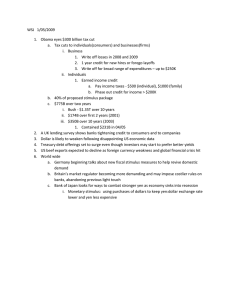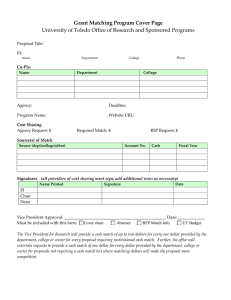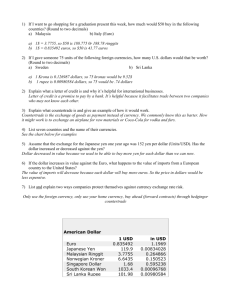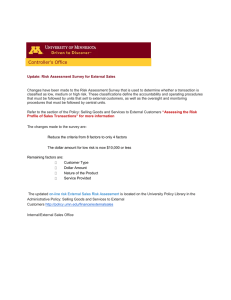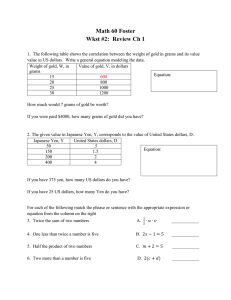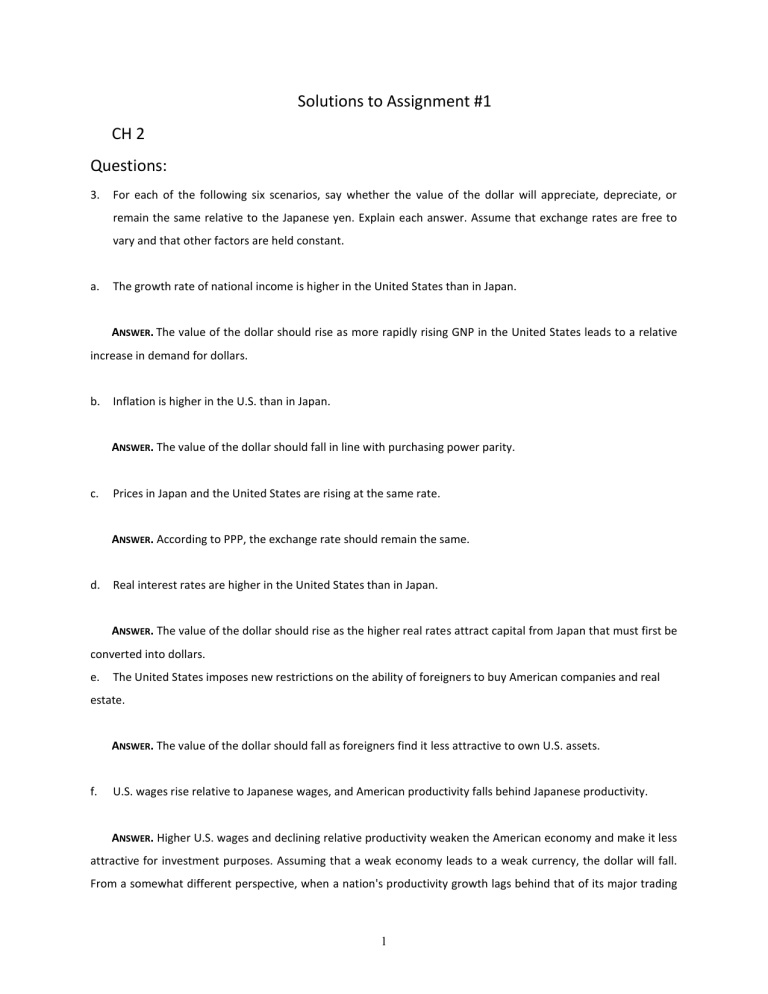
Solutions to Assignment #1 CH 2 Questions: 3. For each of the following six scenarios, say whether the value of the dollar will appreciate, depreciate, or remain the same relative to the Japanese yen. Explain each answer. Assume that exchange rates are free to vary and that other factors are held constant. a. The growth rate of national income is higher in the United States than in Japan. ANSWER. The value of the dollar should rise as more rapidly rising GNP in the United States leads to a relative increase in demand for dollars. b. Inflation is higher in the U.S. than in Japan. ANSWER. The value of the dollar should fall in line with purchasing power parity. c. Prices in Japan and the United States are rising at the same rate. ANSWER. According to PPP, the exchange rate should remain the same. d. Real interest rates are higher in the United States than in Japan. ANSWER. The value of the dollar should rise as the higher real rates attract capital from Japan that must first be converted into dollars. e. The United States imposes new restrictions on the ability of foreigners to buy American companies and real estate. ANSWER. The value of the dollar should fall as foreigners find it less attractive to own U.S. assets. f. U.S. wages rise relative to Japanese wages, and American productivity falls behind Japanese productivity. ANSWER. Higher U.S. wages and declining relative productivity weaken the American economy and make it less attractive for investment purposes. Assuming that a weak economy leads to a weak currency, the dollar will fall. From a somewhat different perspective, when a nation's productivity growth lags behind that of its major trading 1 partners, the other countries will become more depreciating currency is the market's way of restoring balance. The lagging country regains its balance, but only by accepting a lower real price for its goods. In effect, the cheaper currency is the market's way of cutting wages in the lagging country. SUGGESTED SOLUTIONS TO CHAPTER 2 PROBLEMS 1. On August 8, 2000, Zimbabwe changed the value of the Zim dollar from Z$38/U.S.$ to Z$50/U.S.$. a. What was the original U.S. dollar value of the Zim dollar? What is the new U.S. dollar value of the Zim dollar? ANSWER. The U.S. dollar value of the Zim dollar prior to devaluation was $0.0263 (1/38). Subsequent to devaluation, the Zim dollar was worth $0.02 (1/50). b. By what percent has the Zim dollar devalued (revalued) relative to the U.S. dollar? ANSWER. The U.S. dollar value of the Zim dollar has changed by (0.02 - 0.0263)/0.0263 = -24%. Thus, the Zim dollar has devalued by 24% against the U.S. dollar. c. By what percent has the U.S. dollar appreciated (depreciated) relative to the Zim dollar? ANSWER. The U.S. dollar has appreciated against the Zim dollar by an amount equal to (50 - 38)/38 = 31.58%. 2. In 1995, one dollar bought ¥80. In 2000, it bought about ¥110. a. What was the dollar value of the yen in 1995? What was the yen’s dollar value in 2000? ANSWER. The dollar value of the yen in 1995 was $0.0125 (1/80). By 2000, the yen had fallen to $0.00909. b. By what percent has the yen fallen in value between 1995 and 2000? ANSWER. Between 1995 and 2000, the yen fell by 27.27%, calculated as (0.00909 - 0.0125)/0.0125. c. By what percent has the dollar risen in value between 1995 and 2000? ANSWER. During this same period, the dollar appreciated by 37.5%, calculated as (110 - 80)/80. 3. On February 1, the euro is worth $0.8984. By May 1, it has moved to $0.9457. 2 a. By how much has the euro appreciated or depreciated against the dollar over this 3-month period? ANSWER. Since the euro is now worth more in dollar terms, it has appreciated against the dollar. The amount of euro appreciation is (0.9457 - 0.8984)/0.1984 = 5.27%. b. By how much has the dollar appreciated or depreciated against the euro over this period? ANSWER. The flip side of euro appreciation is dollar depreciation. The dollar has depreciated by an amount equal to 1 1 0.9457 0.8984 = 0.8984 - 0.9457 = - 5.00% 1 0.9457 0.8984 CHAPTER 5 5. During the Reagan era, 1981-1988, the U.S. current account moved from a tiny surplus to a large deficit. The following table provides U.S. macroeconomic data for that period. YEAR PRIVATE SAVINGS PRIVATE INVESTMENT GOVERNMENT BUDGET DEFICIT CURRENT-ACCOUNT BALANCE 1 19 19 198 19 19 19 1 19 980 81 82 3 84 85 86 987 88 5 58 61 641 74 73 72 7 80 00 6 7 3 6 1 31 2 4 55 50 71 71 71 7 79 68 8 3 9 5 8 49 4 - - - - - - - - - 35 30 109 140 109 125 147 112 98 2 5 - -45 - - - - - 100 125 151 167 129 11 a. 547 Based on these data, to what extent would you attribute the changes in the U.S. current-account balance to a decline in the U.S. private savings-investment balance? ANSWER. In 1980, U.S. private savings exceeded private investment by $32 billion. By 1988, this figure had fallen to $8 billion, a change of $24 billion. Over the same period, the U.S. current-account balance went from a 3 surplus of $2 billion to a deficit of $129 billion, a change of $131 billion. Clearly, the change in the U.S. currentaccount balance is only minimally attributable to the change in the U.S. private savings-investment balance. b. To what extent would you attribute the changes in the U.S. current-account balance to an increase in the U.S. government budget deficit? ANSWER. Over the period 1980-1988, the U.S. current-account balance tracked the U.S. government budget deficit much more closely than did the U.S. private savings-investment balance. This relationship can be seen in the following chart, which is based solely on the data presented in the previous table. 100 Based on these data, what was the excess of national spending over national income during this period? ANSWER. Using the identity national income - national expenditure = balance on current account, we can answer this question by summing the current-account balance over this nine-year period. The sum is -$721 billion, indicating that over this period, the United States spent $721 billion more than it earned. CH 7: 1. The $: € exchange rate is €1 = $1.45, and the €/SFr exchange rate is SFr 1 = €0.71. What is the SFr/$ exchange rate? 4 ANSWER. SFr1 = €0.71 x 1.45 = $1.0295. 2. Suppose the direct quote for sterling in New York is 1.9110-5. What is the direct quote for dollars in London? ANSWER. The direct quote for the dollar in London is just the reciprocal of the direct quote for the pound in New York or 1/1.9115 - 1/1.9110 = 0.5231-3. 3. Using the data in Exhibit 7.5, calculate the 30-day, 90-day, and 180-day forward discounts for the Canadian dollar. ANSWER. Here are the relevant rates for the Canadian dollar: Spot: C$1 = $1.0078 30-day forward: C$1 = $1.0073 90-day forward: C$1 = $1.0069 180-day forward: C$1 = $1.0066 The 30-day forward discount is: [($1.0073 - $1.0078)/$1.0078] x 12 = -0.60% The 90-day forward discount is: [($1.0069 - $1.0078)/$1.0078] x 4 = -0.36% The 180-day forward discount is: [($1.0066 - $1.0078)/$1.0078] x 2 = -0.24% In this case, the forward discounts at these maturities are relatively small, indicating that Canadian and U.S. interest rates are close to each other. 4. An investor wishes to buy euros spot (at $1.3908) and sell euros forward for 180 days (at $1.3996). a. What is the swap rate on euros? ANSWER. A premium of 88 points. b. What is the premium on 180-day euros? ANSWER. The 180-day premium is (1.3996 - 1.3908)/1.3908 x 2 = 1.27%. 5 5. Suppose Credit Suisse quotes spot and 90-day forward rates on the Swiss franc of $0.7957-60, 8-13. a. What are the outright 90-day forward rates that Credit Suisse is quoting? ANSWER. The outright forwards are: bid rate = $0.7965 (0.7957 + 0.0008) and ask rate = $0.7973 (0.7960 + 0.0013). b. What is the forward discount or premium associated with buying 90-day Swiss francs? ANSWER. The annualized forward premium = [(0.7973 - 0.7960)/0.7960]x 4 = 0.65%. c. Compute the percentage bid-ask spreads on spot and forward Swiss francs. ANSWER. The bid-ask spread is calculated as follows: Percent spread = Ask price - Bid price x 100 Ask price Substituting in the numbers yields a spot bid-ask spread of (0.7960 - 0.7957)/0.7960 = 0.04%. The corresponding forward bid-ask spread is (0.7973 - 0.7965)/0.7973 = 0.10%. 6. Suppose Dow Chemical receives quotes of $0.009369-71 for the yen and $0.03675-6 for the Taiwan dollar (NT$). a. How many U.S. dollars will Dow Chemical receive from the sale of ¥50 million? ANSWER. Dow must sell yen at the bid rate, meaning it will receive from this sale $468,450 (50,000,000 x 0.009369). b. What is the U.S. dollar cost to Dow Chemical of buying ¥1 billion? ANSWER. Dow must buy at the ask rate, meaning it will cost Dow $9,371,000 (1,000,000,000 x 0.009371) to buy ¥1 billion. c. How many NT$ will Dow Chemical receive for U.S. $500,000? 6 ANSWER. Dow must sell at the bid rate for U.S. dollars (which is the reciprocal of the ask rate for NT$, or 1/0.03676), meaning it will receive from this sale of U.S. dollars NT$13,601,741 (500,000/0.03676). d. How many yen will Dow Chemical receive for NT$200 million? ANSWER. To buy yen, Dow must first sell the NT$200 million for U.S. dollars at the bid rate and then use these dollars to buy yen at the ask rate. The net result from these transactions is ¥784,334,649.45 (200,000,000 x 0.03675/0.009371). e. What is the yen cost to Dow Chemical of buying NT$80 million? ANSWER. Dow must sell the yen for dollars at the bid rate and then buy NT$ at the ask rate with the U.S. dollars. The net yen cost to Dow from carrying out these transactions is ¥313,886,220.51 (80,000,000 x 0.03676/0.009369) 8. a. As a foreign exchange trader at Sumitomo Bank, one of your customers would like a yen quote on Australian dollars. Current market rates are: Spot 30-day ¥101.37-85/U.S.$1 15-13 A$1.2924-44/U.S.$1 20-26 What bid and ask yen cross rates would you quote on spot Australian dollars? ANSWER. By means of triangular arbitrage, we can calculate the market quotes for the Australian dollar in terms of yen as ¥78.31-81/A$1 These prices can be found as follows. For the yen bid price for the Australian dollar, we need to first sell Australian dollars for U.S. dollars and then sell the U.S. dollars for yen. It costs a$1.2944 to buy U.S. $1. With U.S. $1 we can buy ¥101.37. Hence, A$1.2944 = ¥101.37, or A$1 = ¥78.31. This is the yen bid price for the Australian dollar. 7 The yen ask price for the Australian dollar can be found by first selling yen for U.S. dollars and then using the U.S. dollars to buy Australian dollars. Given the quotes above, it costs ¥101.85 to buy U.S. $1, which can be sold for a$1.2924. Hence, A$1.2924 = ¥101.85, or A$1 = ¥78.81. This is the yen ask price for the Australian dollar. As a foreign exchange trader, you would try to buy Australian dollars at slightly less than ¥78.31 and sell them at slightly more than ¥78.81. Buying and selling Australian dollars at the market price will leave you with no profit. How much better than the market prices you can do depends on the degree of competition you face from other traders and the extent to which your customers are willing to shop around to get better quotes. b. What outright yen cross rates would you quote on 30-day forward Australian dollars? ANSWER. Given the swap rates, we can compute the outright forward direct quotes for the yen and Australian dollar by adding or subtracting the forward points as follows Spot 30-day 30-day outright forward rates ¥101.37-85/U.S.$1 15-13 ¥101.22-72/U.S.$1 A$1.2924-44/U.S.$1 20-26 A$1.2944-70/U.S.$1 By means of triangular arbitrage, we can then calculate the market quotes for the 30-day forward Australian dollar in terms of yen as ¥78.04-58/A$1 These prices can be found as follows. For the yen bid price for the forward Australian dollar, we need to first sell Australian dollars forward for U.S. dollars and then sell the U.S. dollars forward for yen. It costs a$1.2970 to buy U.S. $1 forward. With U.S. $1 we can buy ¥101.22. Hence, A$1.2970 = ¥101.22, or A$1 = ¥78.04. This is the yen bid price for the forward Australian dollar. The yen ask price for the Australian dollar can be found by first selling yen forward for U.S. dollars and then using the U.S. dollars to buy forward Australian dollars. Given the quotes above, it costs ¥101.72 to buy U.S. $1, which can be sold for a$1.2944. Hence, A$1.2944 = ¥101.71, or A$1 = ¥78.58. This is the yen ask price for the forward Australian dollar. c. What is the forward premium or discount on buying 30-day Australian dollars against yen delivery? 8 ANSWER. As shown in parts a and b, the ask rate for 30-day forward Australian dollars is ¥78.58 and the spot ask rate is ¥78.81. Thus, the Australian dollar is selling at a forward discount to the yen. The annualized discount equals -3.43%, computed as follows: Forward premium or discount = Forward rate Spot rate 360 78.58 - 78.81 360 x = x = - 3.43% Forward contract Spot rate 78.81 30 number of days CH 8 1. On Monday morning, an investor takes a long position in a pound futures contract that matures on Wednesday afternoon. The agreed-upon price is $1.78 for £62,500. At the close of trading on Monday, the futures price has risen to $1.79. At Tuesday close, the price rises further to $1.80. At Wednesday close, the price falls to $1.785, and the contract matures. The investor takes delivery of the pounds at the prevailing price of $1.785. Detail the daily settlement process (see Exhibit 8.3). What will be the investor's profit (loss)? ANSWER Time Action Cash Flow ------------------------------------------------------------------------------------------------------------------------------------------Monday Investor buys pound futures morning contract that matures in two None days. Price is $1.78. Monday close Tuesday Futures price rises to $1.79. Investor receives Contract is marked-to-market. Futures price rises to $1.80. 62,500 x (1.79 - 1.78) = $625. Investor receives close Contract is marked-to-market. 62,500 x (1.80 - 1.79) = $625. Wednesday Futures price falls to $1.785. (1) Investor pays close (1) Contract is marked-to-market. 62,500 x (1.80 -1.785) = $937.50 (2) Investor takes delivery of £62,500. (2) Investor pays 62,500 x 1.785 = $111,562.50. 9 Net profit is $1,250 - 937.50 = $312.50. 2. Suppose that the forward ask price for March 20 on euros is $0.9127 at the same time that the price of IMM euro futures for delivery on March 20 is $0.9145. How could an arbitrageur profit from this situation? What will be the arbitrageur's profit per futures contract (size is €125,000)? ANSWER. Since the futures price exceeds the forward rate, the arbitrageur should sell futures contracts at $0.9145 and buy euro forward in the same amount at $0.9127. The arbitrageur will earn 125,000(0.9145 - 0.9127) = $225 per euro futures contract arbitraged. 3. Suppose that DEC buys a Swiss franc futures contract (contract size is SFr 125,000) at a price of $0.83. If the spot rate for the Swiss franc at the date of settlement is SFr 1 = $0.8250, what is DEC's gain or loss on this contract? ANSWER. DEC has bought Swiss francs worth $0.8250 at a price of $0.83. Thus, it has lost $0.005 per franc for a total loss of 125,000 x .005 = $625. 4. On January 10, Volkswagen agrees to import auto parts worth $7 million from the United States. The parts will be delivered on March 4 and are payable immediately in dollars. VW decides to hedge its dollar position by entering into IMM futures contracts. The spot rate is $0.8947/€ and the March futures price is $0.9002/€. a. Calculate the number of futures contracts that VW must buy to offset its dollar exchange risk on the parts contract. ANSWER. Volkswagen can lock in a euro price for its imported parts by buying dollars in the futures market at the current March futures price of €1.1109/$1 (1/0.9002). This is equivalent to selling euro futures contracts. At that futures price, VW will sell €7,776,050 for $7 million. At €125,000 per futures contract, this would entail selling 62 contracts (7,776,050/125,000 = 62.21) at a total cost of €7,750,000. b. On March 4, the spot rate turns out to be $0.8952/€, while the March futures price is $0.8968/€. Calculate VW's net euro gain or loss on its futures position. Compare this figure with VW's gain or loss on its unhedged position. 10 ANSWER. Under its futures contract, Volkswagen has agreed to sell €7,750,000 and receive $6,976,550 (7,750,000 x 0.9002). On March 4, VW can close out its futures position by buying back 62 March euro futures contracts (worth €7,750,000). At the current futures rate of $0.8968/€, VW must pay out $6,950,200 (7,750,000 x 0.8968). Hence, VW has a net gain of $26,350 ($6,976,550 - $6,950,200) on its futures contract. At the current spot rate of $0.8952/€, this translates into a gain of €29,434.76 (26,350/0.8952). Upon closing out the 62 futures contracts, VW will then buy $7 million in the spot market at a spot rate of $0.8952/€. Its net cost is €7,790,046.92 (7,000,000/0.8952 - 29,434.76). If VW had not hedged its import contract, it could have bought the $7 million on March 10 at a cost of € 7,819,481.68 (7,000,000/0.8952). This contrasts with a projected cost based on the spot rate on January 10th of €7,823,851.57 (7,000,000/0.8947). However, the latter “cost” is irrelevant since VW had no opportunity to buy March dollars at the January 10th spot rate of $0.8947/€. By not hedging, VW would have paid an extra €29,434.76 for the $7,000,000 to satisfy its dollar liability, the difference between the cost of $7 million with hedging (€ 7,790,046.92) and the cost without hedging (€7,819,481.68). 5. Citigroup sells a call option on euros (contract size is €500,000) at a premium of $0.04 per euro. If the exercise price is $0.91 and the spot price of the euro at date of expiration is $0.93, what is Citigroup's profit (loss) on the call option? ANSWER. Since the spot price of $0.93 exceeds the exercise price of $0.91, Citigroup's counterparty will exercise its call option, causing Citigroup to lose 2¢ per euro. Adding in the 4¢ call premium it received gives Citigroup a net profit of 2¢ per euro on the call option for a total gain of .02 x 500,000 = $10,000. 6. Suppose you buy three June PHLX call options with a 90 strike price at a price of 2.3 (¢/€). a. What would be your total dollar cost for these calls, ignoring broker fees? ANSWER. With each call option being for €62,500, the three contracts combined are for €187,500. At a price of 2.3¢/€, the total cost is therefore 187,500 x $0.023 = $4,312.50. b. After holding these calls for 60 days, you sell them for 3.8 (¢/€). What is your net profit on the contracts assuming that brokerage fees on both entry and exit were $5 per contract and that your opportunity cost was 8% per annum on the money tied up in the premium? 11 ANSWER. The net profit would be 1.5¢/€ (3.8 - 2.3) for a total profit before expenses of $2,812.50 (0.015 x 187,500). Brokerage fees totaled $10 per contract or $30 overall. The opportunity cost would be $4,312.50 x 0.08 x 60/365 = $56.71. After deducting these expenses (which total $86.71), the net profit is $2,725.79. 8. Apex Corporation must pay its Japanese supplier ¥125 million in three months. It is thinking of buying 20 yen call options (contract size is ¥6.25 million) at a strike price of $0.00800 in order to protect against the risk of a rising yen. The premium is 0.015 cents per yen. Alternatively, Apex could buy 10 three-month yen futures contracts (contract size is ¥12.5 million) at a price of $0.007940 per yen. The current spot rate is ¥1 = $0.007823. Suppose Apex's treasurer believes that the most likely value for the yen in 90 days is $0.007900, but the yen could go as high as $0.008400 or as low as $0.007500. a. Diagram Apex's gains and losses on the call option position and the futures position within its range of expected prices (see Exhibit 8.4). Ignore transaction costs and margins. ANSWER. In all the following calculations, note that the current spot rate is irrelevant. When a spot rate is referred to, it is the spot rate in 90 days. If Apex buys the call options, it must pay a call premium of 0.00015 x 125,000,000 = $18,750. If the yen settles at its minimum value, Apex will not exercise the option and it loses the call premium. But if the yen settles at its maximum value of $0.008400, Apex will exercise at $0.008000 and earn $0.0004/¥1 for a total gain of .0004 x 125,000,000 = $50,000. Apex's net gain will be $50,000 - $18,750 = $31,250. PROFIT (LOSS) ON APEX CORPORATION'S FUTURES AND OPTIONS POSITIONS 12 OPTION 75 79.4 Inflow -- -- 81.5 84 $1,018,75 $1,050,00 0 0 -18,750 - Outflow Call -$18,750 -$18,750 Premium 1,000,000 Exercise -- -- Cost Profit - -18,750 1,000,000 ________ ________ ________ ________ ___ __ __ __ -$18,750 -$18,750 $0 $31,250 $937,500 $992,500 $1,000,00 $1,050,00 0 0 FUTURES Inflow Outflow Profit -992,500 -992,500 -992,500 -992,500 ________ ________ ________ ________ __ __ __ __ -$55,000 $0 $7,500 $57,500 As the diagram shows, Apex can use a futures contract to lock in a price of $0.007940/¥ at a total cost of .007940 x 125,000,000 = $992,500. If the yen settles at its minimum value, Apex will lose $0.007940 - $0.007500 = $0.000440/¥ (remember it is buying yen at 0.007940, when the spot price is only 0.007500), for a total loss on the futures contract of 0.00044 x 125,000,000 = $55,000. On the other hand, if the yen appreciates to $0.008400, Apex will earn $0.008400 - $0.007940 = $0.000460/¥ for a total gain on the futures contracts of 0.000460 x 125,000,000 = $57,500. b. Calculate what Apex would gain or lose on the option and futures positions if the yen settled at its most likely value. ANSWER. If the yen settles at its most likely price of $0.007900, Apex will not exercise its call option and will lose the call premium of $18,750. If Apex hedges with futures, it will have to buy yen at a price of $0.007940 when the spot rate is $0.0079. This will cost Apex $0.000040/¥, for a total futures contract cost of 0.000040 x 125,000,000 = $5,000. 13 c. What is Apex's break-even future spot price on the option contract? On the futures contract? ANSWER. On the option contract, the spot rate will have to rise to the exercise price plus the call premium for Apex to break even on the contract, or $0.008000 + $0.000150 = $0.008150. In the case of the futures contract, break-even occurs when the spot rate equals the futures rate, or $0.007940. d. Calculate and diagram the corresponding profit and loss and break-even positions on the futures and options contracts for the sellers of these contracts. ANSWER. The sellers' profit and loss and break-even positions on the futures and options contracts will be the mirror image of Apex's position on these contracts. For example, the sellers of the futures contract will breakeven at a future spot price of ¥1 = $0.007940, while the options sellers will breakeven at a future spot rate of ¥1 = $0.008150. Similarly, if the yen settles at its minimum value, the options sellers will earn the call premium of $18,750 and the futures sellers will earn $55,000. But if the yen settles at its maximum value of $0.008400, the options sellers will lose $31,250 and the futures sellers will lose $57,500. CH. 9 1. Dell Computers would like to borrow pounds, and Virgin Airlines wants to borrow dollars. Because Dell is better known in the United States, it can borrow on its own dollars at 7 percent and pounds at 9 percent, whereas Virgin can on its own borrow dollars at 8 percent and pounds at 8.5% a. Suppose Dell wants to borrow £10 million for two years, Virgin wants to borrow $16 million for two years, and the current ($/£) exchange rate is $1.60. What swap transaction would accomplish this objective? Assume the counterparties would exchange principal and interest payments with no rate adjustments. ANSWER. Virgin would borrow £10 million for two years and Dell would borrow $16 million for two years. The two companies would then swap their proceeds and payment streams. b. What savings are realized by Dell and Virgin? ANSWER. Assuming no interest rate adjustments, Dell would pay 8.5% on the £10 million and Virgin would pay 7% on its $16 million. Given that its alternative was to borrow pounds at 9%, Dell would save 0.5% on its borrowings, or an annual savings of £50,000. Similarly, Virgin winds up paying an interest rate of 7% instead of 8% on its dollar borrowings, saving it 1% or $160,000 annually. 14 c. Suppose, in fact, that Dell can borrow dollars at 7 percent and pounds at 9 percent, whereas Virgin can borrow dollars at 8.75 percent and pounds at 9.5 percent. What range of interest rates would make this swap attractive to both parties? ANSWER. Ignoring credit risk differences, Virgin would have to provide Dell with a pound rate of less than 9%. Given that Virgin has to borrow the pounds at 9.5%, it would have to save at least 0.5% on its dollar borrowing from Dell to make the swap worthwhile. If Dell borrows pounds from Virgin at 9% - x. then Virgin would have to borrow dollars from Dell at 8.75% - (0.5% + x) to cover the 0.5% + x difference between the interest rate at which it was borrowing pounds and the interest rate at which it was lending those pounds to Dell. d. Based on the scenario in part (c), suppose Dell borrows dollars at 7 percent and Virgin borrows pounds at 9.5 percent. If the parties swap their current proceeds, with Dell paying 8.75 percent to Virgin for pounds and Virgin paying 7.75 percent to Dell for dollars, what are the cost savings to each party? ANSWER. Under this scenario, Dell saves 0.25% on its pound borrowings and earns 0.75% on the dollars it swaps with Virgin, for a total benefit of 1% annually. Virgin loses 0.75% on the pounds it swaps with Dell and saves 1% on the dollars it receives from Dell, for a net savings of 0.25% annually. 5. Suppose LIBOR3 is 7.93 percent and LIBOR6 is 8.11 percent. What is the forward forward rate for a LIBOR3 deposit to be placed in three months? ANSWER. Through arbitrage, the future value in six months of $1 invested today must be the same whether we invest at LIBOR3 today and enter into a forward forward for the following three months or invest at LIBOR6 today. That is, (1 + LIBOR3/4)(1 + r/4) = 1 + LIBOR6/2 where r equals the forward forward rate for a LIBOR3 deposit to be placed in three months. Substituting in numbers from the problem, we have 1.0198(1 + r/4) = 1.04055. Solving this equation yields r = 8.13%. 6. Suppose that Skandinaviska Ensilden Banken (SEB), the Swedish bank, funds itself with three-month Eurodollar time deposits at LIBOR. Assume that Alfa Laval comes to SEB seeking an one-year, fixed-rate loan of $10 million, with interest to be paid quarterly. At the time of the loan disbursement, SEB raises three-month funds at 5.75%, but has to roll over this funding in three successive quarters. If it does not lock in a funding rate and interest rates rise, the loan could prove to be unprofitable. The three quarterly re-funding dates fall shortly before the next three Eurodollar futures-contract expirations in March, June, and September. 15 a. At the time the loan is made, the price of each contract is 94.12, 93.95, and 93.80. Show how SEB can use Eurodollar futures contracts to lock in its cost of funds for the year. What is SEB's hedged cost of funds for the year? ANSWER. The formula for the locked-in LIBOR, r, given a price P of a Eurodollar futures contract is r = 100 - P. Using this formula, the solution r for each of the contracts is 5.82%, 6.05%, and 6.2%. So SEB can lock in a cost for its $10 million loan equal to $10,000,000 x (1 + 0.0575/4)(1 + 0.0582/4)(1 + 0.0605)(1 + 0.062/4) = $10,608,927, which is equivalent to a one-year fixed interest rate of 6.09%. Effectively, what this procedure does is to roll over the principal and cumulative interest payment each quarter until it is paid off in a lump sum at the end of the fourth quarter. b. Suppose that the settlement prices of the March, June, and September contracts are, respectively, 92.98, 92.80, and 92.66. What would have been SEB's unhedged cost of funding the loan to Alfa Laval? ANSWER. We can solve this problem by using the insight that at the time of settlement, arbitrage will ensure that the settlement price for a Eurodollar futures contract will be virtually identical to the actual LIBOR on that date. Given the stated prices at settlement, actual LIBOR on each rollover date was 7.02%, 7.2%, and 7.34%. Based on these figures, the unhedged cost of the loan is $10,000,000 x (1 + 0.0575/4)(1 + 0.0702/4)(1 + 0.072/4)(1 + 0.0734/4) = $10,700,379. This is equivalent to an annual rate of 7.00%, or 91 basis points more than the hedged cost of the loan. 16

